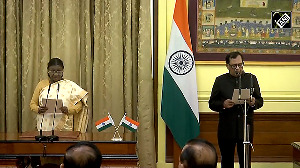Recent newspaper reports indicate that fast-track approval is being sought for an 18.7-km-long metro link from Connaught Place to the International Airport in Delhi. This project, costing Rs 3,811 crore (Rs 38.11 billion), needs to be approved in a few days if construction is to be completed before the forthcoming Commonwealth Games to be held in the Capital of India.
The amount of public funds involved is huge and it is surprising that such an outlay is being considered without adequate public disclosure and an examination of alternatives.
If we just take a conservative cost of capital involved at 4 per cent interest and 4 per cent depreciation rates, it amounts to about Rs 305 crore (Rs 3.05 billion) a year, or Rs 83 lakh (Rs 8.3 million) per day.
For this amount we can give free transport to about 2,000 passengers by helicopter, or 20,000 by air-conditioned taxi, or 100,000 by air-conditioned bus daily. Quite clearly, the project needs a second look.
The proposed high-speed metro line is expected to run from Connaught Place to the airport, stopping at Shivaji Terminal and Moti Bagh on the way. It is expected to carry a maximum of about 2,000 passengers per hour in 2011 and 4,000 per hour in 2021.
This, when metro systems are justified only when the load is more than 20,000 per hour. The promoters base these figures on a survey done by them, which indicated that 82 per cent of the passengers are willing to shift to the metro running from Connaught Place!
It is also claimed that the maximum airport traffic is between the airport and Connaught Place and its vicinity. We do not know how these surveys were done and their scientific validity. Therefore, even the low ridership figures used for justification may be exaggerated.
The project is also justified on the basis that at present on average, the travel time to the airport for passengers is 40-50 minutes, and goes up to more than one hour during peak hours. The metro link is expected to transport passengers at high speed to Connaught Place in about 20 minutes, thus saving time. But, let us look at the trip a little more carefully.
After leaving the Customs area the passenger has to buy a ticket and then take his luggage to the platform. This, on average, takes a minimum of 5 minutes, traversing metro passages and escalators. If the train runs every 15 minutes, you have an average of 7-8 minutes' wait.
Then 20 minutes in the metro, another 5 minutes to get out the station, and another 5 minutes finding a taxi or car. By the time you get into the taxi you have already spent about 40 minutes and moved your luggage on the station twice and twice inside the train.
You save time only if you live in the metro station or few minutes away. Since most passengers don't live very close to Connaught Place, Shivaji Terminal, or Moti Bagh, we can easily add another half an hour to the trip when there is no congestion. Additionally, each one of these three metro stations will attract a few thousand cars and taxis extra hourly to central Delhi, thus making it even more congested.
So, what are the alternatives? Actually they are staring us in the face and the government has already invested in them. An eight-lane expressway from Dhaula Kuan to the airport and beyond is going to be completed very soon. It is time we thought of using this facility more efficiently.
Most airports that have an expressway close by chose to reserve one lane for high-occupancy vehicles. Only buses, taxis, ambulances and police vehicles are allowed on these lanes.
We can do the same and then passengers will have very fast transport into the city and locations in Gurgaon, Manesar, etc. The government has also decided to build a peripheral expressway around Delhi that will be available to passengers going to towns in the Capital region.
This facility can be further augmented by clever use of the inner and outer Ring Roads in Delhi, which can be accessed from the expressway from the airport. Airport link buses can be run on these high-speed corridors and terminals established at strategic locations where passengers can access their personal transport or taxis.
The Delhi Transport Corporation owns a huge amount of real estate, occupied by its dozens of depots spread all over Delhi. These could be transformed into beautiful terminals. Thus no location will become a new congestion point.
Efficiency and convenience can be enhanced manifold by use of modern computer systems and information technology. Passengers can indicate their destination or origin, and pay for airport transfer when buying their tickets. This information can then be used to group passengers by their arrival/departure time and destination/origin by an optimisation algorithm on a computer.
As soon as the passenger leaves the Customs area, she can be directed to a pre-assigned van or bus departing in less than 10-15 minutes. On arrival at the bus terminal, a pre-assigned taxi can take the passenger home hassle-free.
The above alternative can be put in place within a year and with minimal capital expenditure. It also has the advantage of being flexible and we don't need to forecast future traffic volumes accurately right now.
On the other hand, if the metro link planned turns out to be a white elephant five years from now, we'll be told that some consultant had made erroneous forecasts in the past!
The author is Professor and Coordinator, Transportation Research and Injury Prevention Programme, IIT Delhi





